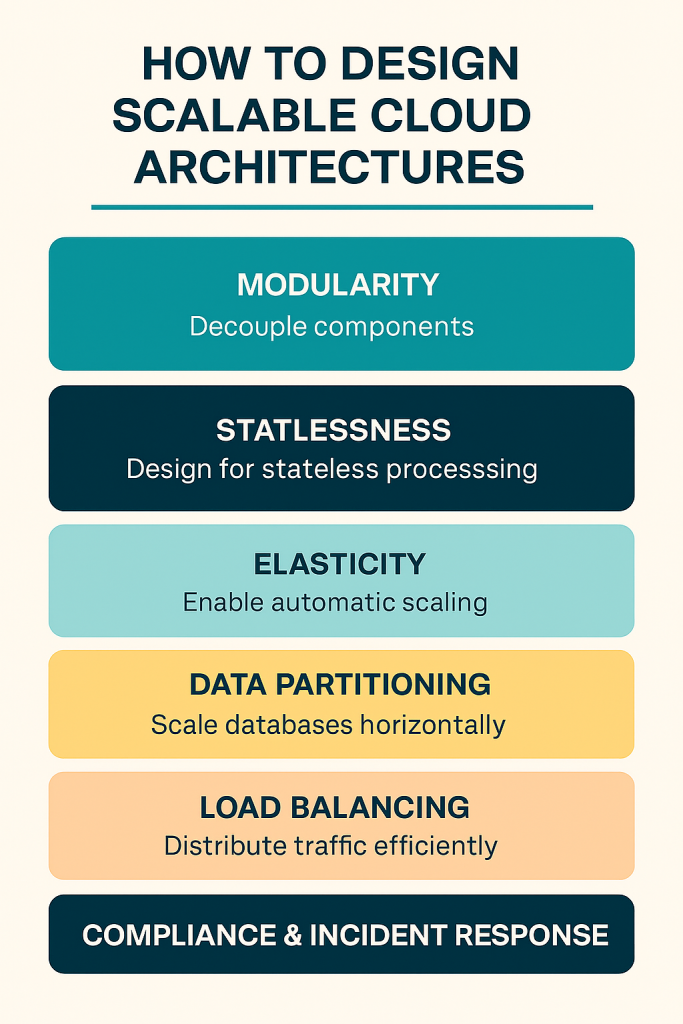How to Design Scalable Cloud Architectures
Scalability is one of the defining advantages of cloud computing. A well-designed cloud architecture can handle growth in users, data, and workloads without sacrificing performance, reliability, or security. For architects, the challenge is to create systems that can expand seamlessly while remaining cost-efficient and manageable. This guide outlines the principles, patterns, and practices that enable scalable cloud solutions.

Understanding Scalability
Scalability refers to a system’s ability to handle increasing workloads by adding resources without degrading performance. There are two primary types:
- Vertical Scaling (Scale Up): Increasing the capacity of a single resource, such as adding more CPU, memory, or storage to a server. This is straightforward but limited by hardware constraints.
- Horizontal Scaling (Scale Out): Adding more instances or nodes to distribute the load. This is preferred in cloud environments because it offers greater flexibility and fault tolerance.
A scalable architecture should support both approaches where appropriate, but modern cloud-native designs typically emphasize horizontal scaling for elasticity and resilience.
Core Design Principles
1. Modularity and Loose Coupling
Breaking systems into smaller, independent components makes scaling more targeted and efficient.
- Microservices Architecture: Each service handles a specific function and can be scaled independently.
- API-Driven Integration: Services communicate through well-defined APIs, reducing dependencies.
2. Statelessness
Stateless components are easier to scale because they do not rely on local session data.
- Store session state in distributed caches like Redis or managed services such as AWS ElastiCache or Azure Cache for Redis.
- Design services so that any instance can handle any request.
3. Elasticity
Elasticity is the ability to automatically adjust resources based on demand.
- Use auto-scaling groups in AWS or virtual machine scale sets in Azure.
- Define scaling policies based on metrics such as CPU utilization, request latency, or queue length.
4. Data Partitioning and Replication
Data can become a bottleneck if not designed for scale.
- Sharding: Split data across multiple databases or partitions.
- Replication: Maintain copies of data across regions for performance and disaster recovery.
- Use managed database services that support horizontal scaling, such as Amazon Aurora or Google Cloud Spanner.
5. Load Balancing
Distribute traffic evenly to prevent overload on any single resource.
- Use global load balancers like AWS Elastic Load Balancing, Azure Front Door, or Google Cloud Load Balancing.
- Implement health checks to route traffic only to healthy instances.
Architectural Patterns for Scalability
Microservices
- Enables independent scaling of services.
- Facilitates continuous deployment and fault isolation.
Event-Driven Architecture
- Decouples producers and consumers using message queues or event streams (e.g., Amazon SQS, Apache Kafka).
- Allows asynchronous processing and better handling of traffic spikes.
Serverless Computing
- Automatically scales based on demand without manual provisioning.
- Ideal for unpredictable workloads and event-driven tasks.
Multi-Region Deployment
- Improves latency and availability by serving users from the nearest region.
- Requires careful data synchronization and compliance considerations.
Operational Best Practices
- Capacity Planning
- Use historical data and predictive analytics to anticipate growth.
- Avoid over-provisioning by leveraging pay-as-you-go models.
- Monitoring and Observability
- Implement centralized logging, metrics, and tracing.
- Use tools like AWS CloudWatch, Azure Monitor, or Prometheus with Grafana.
- Resilience and Fault Tolerance
- Design for failure by using redundant components.
- Implement circuit breakers and graceful degradation strategies.
- Security at Scale
- Apply the principle of least privilege in IAM.
- Encrypt data in transit and at rest.
- Regularly audit configurations with tools like AWS Config or Azure Security Center.
Real-World Example
A global e-commerce platform might:
- Use microservices for catalog, payment, and order management.
- Deploy services across multiple regions with a global load balancer.
- Store product data in a sharded, replicated database.
- Use an event-driven architecture for order processing.
- Implement auto-scaling policies to handle seasonal traffic spikes.
This design ensures that each component can scale independently, traffic is routed efficiently, and the system remains resilient even under extreme load.
Conclusion
Designing scalable cloud architectures requires a combination of sound principles, proven patterns, and operational discipline. By focusing on modularity, statelessness, elasticity, and robust data strategies, architects can build systems that grow with business needs while maintaining performance, security, and cost efficiency. The key is to design with both current and future demands in mind, ensuring that the architecture can adapt to whatever challenges lie ahead.

Leave a Reply